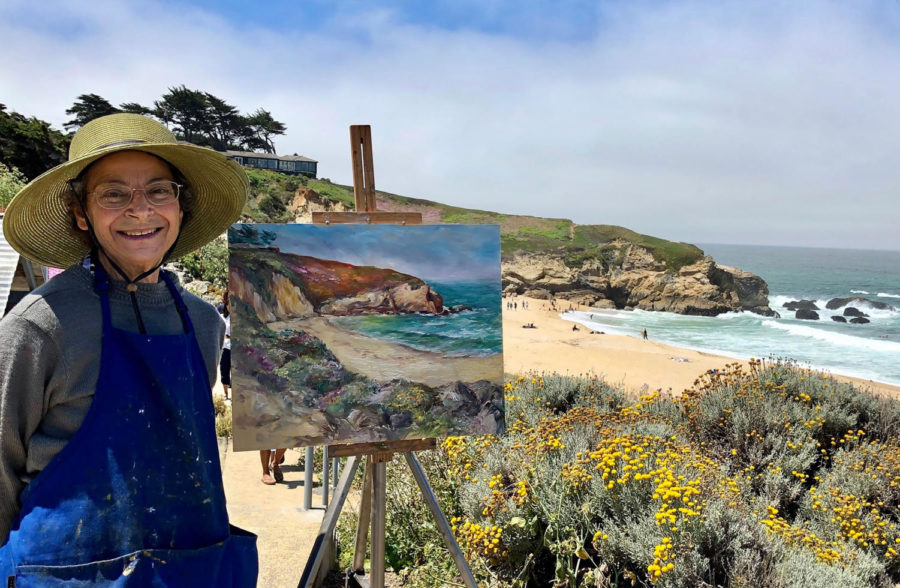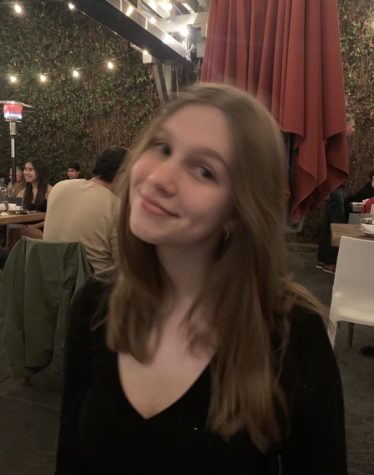Nina Ollikainen’s Experience With Art and Medicine
Nina Ollikainen smiles for a photo while making a “plein air” painting at Montara Beach. Ollikainen often likes to go and paint nature. “I love to be out in nature, go hiking, investigate a location and spend the day painting there,” she said. Photo courtesy of Nina Ollikainen.
January 9, 2022
Menlo art teacher Nina Ollikainen knew that she loved art from a young age. But before she became an art teacher, she was on her way to becoming a doctor. “I guess this is going to become a cautionary tale. How does one make one’s choices? For me, I did it for relationships honoring my parents, nothing with me in my mind [or] what I wanted to do,” Ollikainen said.
Ollikainen grew up in Pacific Palisades, Calif. with her mother, father and older brother. According to Ollikainen, their family was incredibly close. “My parents doted on me and my older brother, but their love seemed conditional, with strings attached,” she said.
Her mother had grown up in a family where all of the men were doctors, and her father was the first one in his family to become a doctor. “So between the two of them, they really cherished and idolized any doctor,” Ollikainen said. She was raised during a time when women were still expected to stay home and raise children, and she wanted to defy that norm. “I felt early on that by becoming a doctor I would keep their love and also be the first woman doctor in the family,” she said.
Ollikainen’s parents were aware of her love for art but told her that she should use that to focus on medical art. “‘Become a medical illustrator, but first become a doctor,’” she said. “This is the path they laid out for me.”
Throughout high school, Ollikainen began to get involved with medical art. It wasn’t until college when Ollikainen began having doubts about her career path. She attended Stanford University where she was pre-med and majored in biology. “I started following my own interests and speaking up for myself in college,” Ollikainen said. “I was already having doubts about being pre-med but did not want to seem to be a quitter. Once I was accepted to medical school I decided to give it a try even though I had great misgivings,” she said.
Ollikainen continued illustrating throughout the duration of her time at college. “I was illustrating the whole vertebrate anatomy lab book at Stanford.” The book was written by other students, but Ollikainen observed dissections and did the illustrations for the book.
Ollikainen got into medical school at the University of Southern California and decided to attend. “I enjoyed parts of it; I actually did,” she said. After completing medical school, Ollikainen had to look into internship residency programs. While she was looking, a relative of hers from San Francisco reached out, recommending a residency in pathology. He knew she was an artist, and he told her that pathology allowed time for him to play violin on the weekends, because it wasn’t as time-consuming as other medical fields. “[He told me] ‘It’s like the least stressful internship residency’ and I believed him,” she said.
Ollikainen got an internship residency in pathology at the University of California, San Francisco. “I [began] doing autopsies which was quite a shocker for me,” she said. “But, it started off rather light at the Veterans Hospital.”
Ollikainen was then rotated around the city, where according to her, everything was more intense. “You could not make a mistake. Everything had to be extremely accurate,” she said. She began to have to do autopsies on people of all ages, including children, which was very upsetting to her. “I was having great weekends and [was] hiking with my future husband […] But I was also probably severely depressed and not admitting it,” she said.
Then, Ollikainen’s older brother, who was starting a private psychiatry practice went missing and was found dead three days later. “He had committed suicide. And that just was it.” Ollikainen decided she had to get out of medicine. “[I realized] ‘I’m not happy with this pathology,’” she said. She quit after two years of residency, technically leaving the residency incomplete.
Ollikainen was 24 at the time. “[I told myself:] ‘I am going to now start doing things I want to do.’” Her parents were not supportive of her decision to leave the medical field. “Pretty much until his last days, my father’s wish was that I go back into medicine,” Ollikainen said. She described having to deal with guilt from making this decision. “It’s always been painful […] having made my choice and being a disappointment. But on the other side of it I know that’s nonsense. Each day I address that,” she said.
According to Ollikainen, she has considered going back into medicine. When her parents were ill and Ollikainen was acting as a caregiver, she even called up a hospital and asked how she would go about finishing her residency. “[The man who answered the phone] asked, ‘Well, how long have you been away from medicine’ and I said ‘30 years,’ and I heard this stifled laughter,” she said. Now, Ollikainen doesn’t feel the urge to be a doctor again. “I’ve really found my calling now,” she said.
After leaving medicine, Ollikainen didn’t immediately get into art, and first settled down and had a family. She believes that raising her kids is what got her into teaching. She began to volunteer at her kid’s schools, which got her involved in many art projects. “I brought my biology training and my art to the classroom,” she said. Ollikainen recalls sewing a 24-foot long intestinal tract and felt organs for the elementary school to pull out of a doll and show how long it is, along with other projects.
Ollikainen went on to design sets for Ohlone Elementary school, which is where she first met the current Technical Director for the Menlo Drama program, Andy Hayes. “I was doing insane, over-the-top decorations for school plays,” Ollikainen said. Hayes and Ollikainen then became involved at Menlo about 27 years ago. “I was painting for the Middle School and [Upper] School, and then I became the designer for all of the Middle School shows too,” she said.
After working on sets at Menlo, a teacher introduced Ollikainen to the Peninsula Bridge Program. This was Ollikainen’s first time officially teaching an art class. On her first day, a little boy in the program asked her how long she had been teaching. “I [responded] ‘how many minutes is this class?’” she said.
Eventually, in 2011 an art teacher position opened up at Menlo when the previous art teacher, Lynn Mouser-Bain retired. This is when Ollikainen officially began teaching art there. “I had about a 17-year history of being behind the scenes at Menlo,” she said.
Ollikainen now uses her life experience as a lesson for students. “Be aware, if you’re incredibly depressed and not happy with doing stuff, then there must be a reason. Be sure to not keep negative feelings bottled up inside you, please seek help and reach out to others,” she said.
Ollikainen is content with her decision to leave medicine and teach art to students. “I think medicine is amazing, but my heart really lay in just creating art and also teaching, so it actually worked out,” she said.



